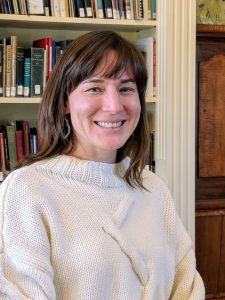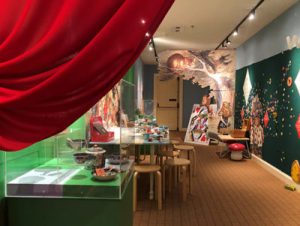by Will Gregg

From the Fairfield Museum and History Center in central Fairfield, Connecticut, Curator Laurie Lamarre merges the town’s past and present in exhibits that appeal to a wide audience.
The Fairfield Museum and History Center is an active space with over 30,000 visitors per year, nearly 5,500 of which are students.[1] Though situated close to Fairfield Beach and downtown Fairfield, and attracting a number of serendipitous visitors from outside the community, most of the museum’s visitors are local. Laurie feels that hers is a community with a passion for cultural heritage, as evidenced by its support for numerous arts organizations: a museum, theatre company, art galleries, and a 10,000 seat auditorium.[2]
Ms. Lamarre seeks to gain community engagement through thought provoking and varied exhibits. The most recent exhibits at the Fairfield Museum include Alice in Museumland, displaying 19th century artifacts in an Alice-in-Wonderland-themed atmosphere, Flappers: Fashion and Freedom, examining “history and social impact of fashion and its relationship to the women’s movement of the 1920s,” and An American Story: Finding Home in Fairfield County, highlighting refugee experiences in Fairfield County.[3]
These exhibits curate a mix of past and present, drawing on collaborations with community members and national and regional artists. Coordinating these efforts requires good communication and long-term relationship building, as most exhibits need to be planned two or three years in advance. Ms. Lamarre feels that the payoff for these efforts is extremely valuable: for exhibits to engage, they need to relate to people as they are in the present.
At the same time, each exhibit must relate to an audience diverse in age, origin, and educational background. Rather than see some exhibits as ‘for adults’ and others ‘for kids,’ Laurie believes that the kinds of learning that appeal to all ages — experiential and imaginative — can be the most effective in a museum setting.[4] For instance, Alice in Museumland features both a text-based guide for adults and a scavenger hunt for kids. The three-dimensional nature of the exhibit moreover lends a whimsical and interactive element, and the space is designed so as to bring groups and families into face-to-face contact with each other.
“We have this understanding,” Laurie commented, “particularly in the academic community, that we can’t learn for real if [the material] isn’t a well researched document. But there are many other kinds of learning.” Text, while certainly important, has played an out sized role: its hegemony on learning is bound up in a tradition that also treats museums as austere and somewhat unapproachable.

Approachability is vital for attracting non-traditional visitors to the museum. One outreach challenge in the case of the Fairfield Museum is the economic divide between itself and the town of Bridgeport. Bridgeport, while also part of Fairfield County, has a mean household income of $66,00 compared to Fairfield’s $184,000.[5] Economic status is a factor in a person’s likelihood to feel at home in traditional museum spaces, and so designing programs and exhibitions with this in mind can be particularly important in conjunction with outreach to schools, nonprofits, and community foundations. Exhibits built on existing connections can also help to form new connections. For instance, exhibits featuring community art bring in many new visitors from that group and from the community as a whole.
On the topic of outreach more generally, Laurie finds “reflection and introspection” to be essential. This effort to understand yourself in relation to your community is a two-way street. Not having grown up in Fairfield, Laurie has found it to be crucial to attend community events and to listen carefully to individuals. “Ours is a Fairfield story,” she remarked. “That’s who we need to appeal to.”
[1] “Fairfield Museum and History Center: About Us.” https://www.fairfieldhistory.org/about/
[2] “About Fairfield. Arts, Culture & Entertainment.” https://www.fairfieldct.org/arts
[3] “Fairfield Museum and History Center: Past Exhibitions.” https://www.fairfieldhistory.org/exhibitions/past-exhibitions/
[4] For more on this topic, see Ms. Lamarre’s TedX talk, “Opening Pathways: Museums and Empathy,” patricularly starting at 6:15. https://youtu.be/zvrqmLfEF1E
[5] U.S. Census Bureau, 2013-2017 American Community Survey 5-Year Estimates
